
New Zealand’s national bird, the Kiwi. Of the five extant species of this flightless bird, all are threatened to a degree and one species, the great white spotted kiwi, is severely endangered. Courtesy of kiwibird.org.
New Zealand is facing a crisis: without swift, radical measures for predator control, many bird species will be drastically reduced if not eradicated. The culprits: all are invasive species introduced by human inhabitants. Rats, stoats, brush-tail possums (not to be confused with the North American opossum), weasels, feral cats and dogs are the primary culprits.
Why there is such a problem with bird predation has a lot to do with how New Zealand has geologically and zoologically developed over the millennium, and with mankind itself.
- The land forms which now make up the North and South Islands of New Zealand separated from the super-large Austro-Asian continent over 80 million years ago, leaving the island geographically isolated from other land masses.
- There are no native land mammals to the islands other than bats. Thus, there are no large predators.
- New Zealand has no snakes and no poisonous animals.
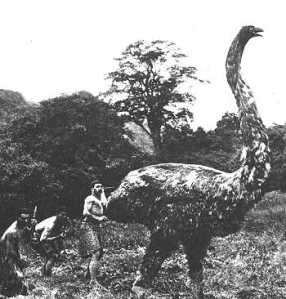 Maori hunters posed with a facsimile of a moa to give perspective on size.
Maori hunters posed with a facsimile of a moa to give perspective on size.- Birds were the most abundant fauna, with many avians becoming highly specialized. Two examples are the now extinct giant Moa, a super-large, ostrich like bird, and, the ground-dwelling kiwis, which range in size from a small turkey to a small hen. (The kiwi is also New Zealand’s national bird.) Over the millennia, both species became flightless with vestigial wings, most likely because they no longer had predators and therefore no longer needed flight as an escape defense.
- The first human inhabitants, the Maori, arrived on the islands about 700+ years ago; Anglo-Europeans about 250 years ago. Both brought non-native animals with them: the Maori brought rats and dogs, the Anglos introduced many more invasive species.
- Most of these non-native mammals were introduced with good but short-sighted intentions, but with present-day catastrophic results in this small island nation: with no larger animals as natural predators, stoats, rats, possums, ferrets and weasels are killing off New Zealand bird species at astonishing rates, some by eating eggs and chicks, the larger animals such as stoats and possums, killing adult birds.
 The NZ Dept. of Conservation has listed the stoat as the country’s Public Enemy #1 for bird predation.
The NZ Dept. of Conservation has listed the stoat as the country’s Public Enemy #1 for bird predation. The brush-tail possum was introduced from its native Australia into NZ to establish a fur trade. The marsupial has wreaked havoc among the bird population, and is thus a close second to the stoat as the major threat to many bird species. Courtesy of csse.monash.edu.au.
The brush-tail possum was introduced from its native Australia into NZ to establish a fur trade. The marsupial has wreaked havoc among the bird population, and is thus a close second to the stoat as the major threat to many bird species. Courtesy of csse.monash.edu.au.The “Battle for our Birds”
The Department of Conservation has embarked on a nation-wide campaign, “Battle for our Birds,” through predator control with intensified trapping as well as aerial applications of a biodegradable toxin of DOC lands, primarily in the lesser populated South Island. Additionally, many local governments and private conservation organizations have taken steps locally to reduce predator populations, especially rats, stoats and possums.
In the last two weeks we visited a few localities where bird conservation has become a serious mission. For the most part, these local efforts have a multi-step approach:
- Eradicate the predators.
- Restore native trees and other vegetation to attract and sustain native birds.
- Where necessary, re-introduce native birds to the wild in protected areas, and if this is not possible, to establish sanctuaries. In this last instance, it may be necessary for sanctuaries to use intense mesh fencing or other means to prevent predator invasion, to continue to trap predators that do invade, and, to supplement the diet of birds within the sanctuaries. This last is especially true if the sanctuary is caring long-term for injured or older birds that cannot be re-introduced into the wild.
We visited a few bird sanctuary areas in the Bay of Islands, the Otorohanga Kiwi House in the mid-North Island, and Zealandia in Wellington. All were different in their approach but had the common goal of eradicating the predators and saving New Zealand’s native bird populations.
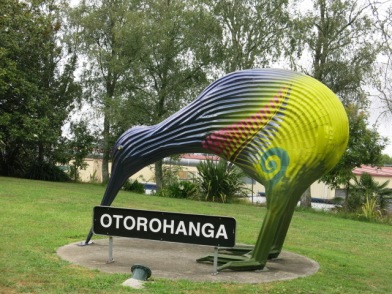
A colorful rendition of a feeding kiwi on the outskirts of Otorohanga, advertising their Kiwi House sanctuary for New Zealand birds, featuring, of course, the kiwi.
Below is a photo array of some of New Zealand’s birds. Enjoy!
 The great spotted kiwi is the largest of the five species of kiwi native only to NZ. The Kiwi House holds 2 of the 3 only to be held in captivity. The bird is the size of a small turkey, highly territorial and aggressive, but numbers no more than about 15,000 in the wild. The spotted great kiwi is considered highly vulnerable. Courtesy of Dept. of Conservation, NZ.
The great spotted kiwi is the largest of the five species of kiwi native only to NZ. The Kiwi House holds 2 of the 3 only to be held in captivity. The bird is the size of a small turkey, highly territorial and aggressive, but numbers no more than about 15,000 in the wild. The spotted great kiwi is considered highly vulnerable. Courtesy of Dept. of Conservation, NZ.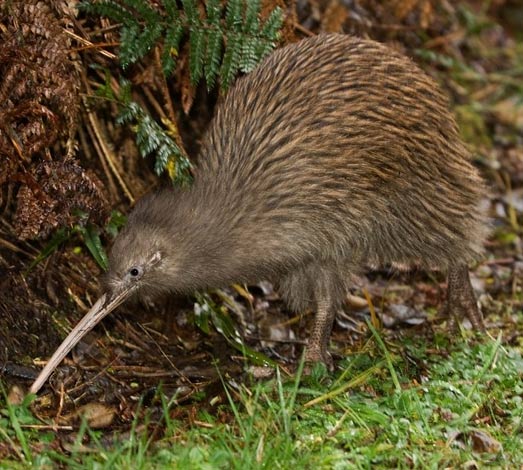 The brown kiwi is the most common of the five species in NZ yet still considered vulnerable. Like all kiwi, it has poor eyesight but good hearing and an excellent sense of smell. Most unusually for birds, kiwi have external nostrils at the end of its long, curved beak. The beak is used to probe the ground for submerged insects, and the nostrils help locate the prey.
The brown kiwi is the most common of the five species in NZ yet still considered vulnerable. Like all kiwi, it has poor eyesight but good hearing and an excellent sense of smell. Most unusually for birds, kiwi have external nostrils at the end of its long, curved beak. The beak is used to probe the ground for submerged insects, and the nostrils help locate the prey.
The kaka is a large, forest-dwelling parrot indigenous to NZ. It is highly vulnerable to endangered in the wild. The kaka is an extremely smart bird whose intelligence is compared to that of the great apes. Photo by Carol Rolnick at Zealandia.
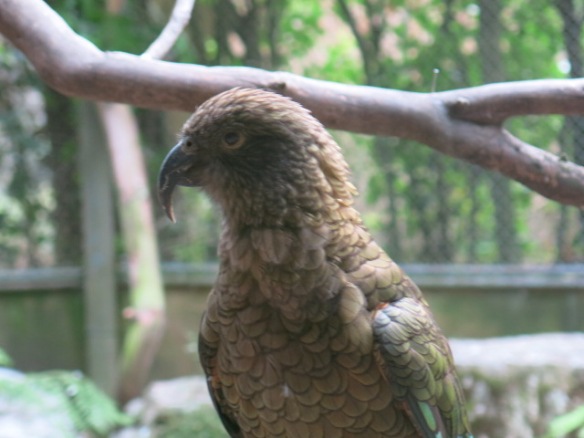
The kea is a large, alpine parrot. Insatiably curious and “cheeky,” the kea likes to investigate backpacks and open car windows, often shredding packs and upholstery to bits with its sharp beak and talons. Photo by Carol Rolnick at the Kiwi House.
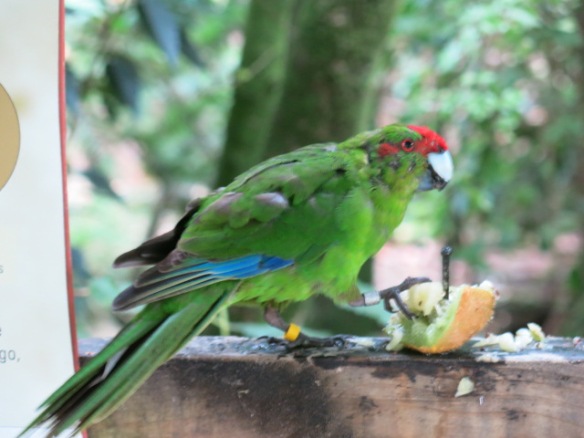
A red-crested kakariki, a small parrot. Photo by Carol Rolnick at the Kiwi House.
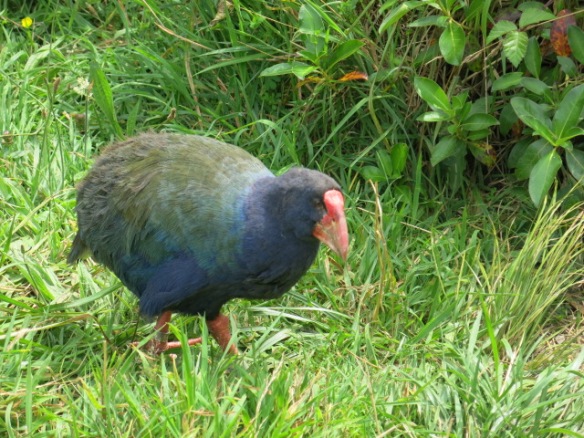
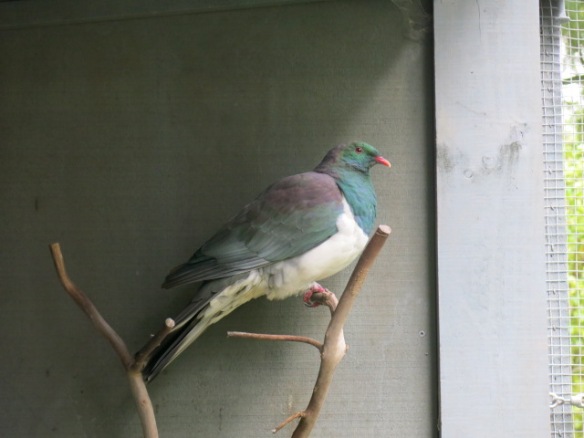
A kereru, or native NZ pigeon, is far larger than the average pigeon. Photo by Carol Rolnick at the Kiwi House.
 The tui bird, a very colorful and talkative bird. Its most easily distinguished charactereistic is the white “ruff” or clutch of feathers at the throat. Courtesy of tuiscope.co.nz.
The tui bird, a very colorful and talkative bird. Its most easily distinguished charactereistic is the white “ruff” or clutch of feathers at the throat. Courtesy of tuiscope.co.nz.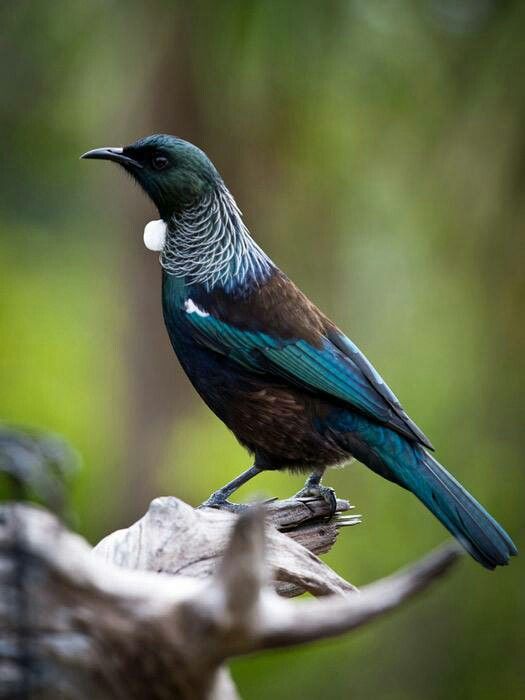 Anothere tui bird. From pinterest.com.
Anothere tui bird. From pinterest.com. The hihi bird, characterized by its up-tilted tail. Courtesy of Heather Arthur from pinterest.com.
The hihi bird, characterized by its up-tilted tail. Courtesy of Heather Arthur from pinterest.com.That’s all folks — for now!
![]()

Carol Barbier Rolnick grew up in Japan and Southeast Asia, traveling extensively as a child through Asia, the Mideast and Europe on family vacations. Travel has continued as a priority through raising kids and continuing into retirement, extending adventures through the Americas, southern Africa, Asia, and repeat trips throughout Europe. Carol and her husband, Michael spent four summers based in Utrecht, The Netherlands, which has become like a second home. They are (still) aiming towards Australia-New Zealand and Antarctica to round off their continental travels.








